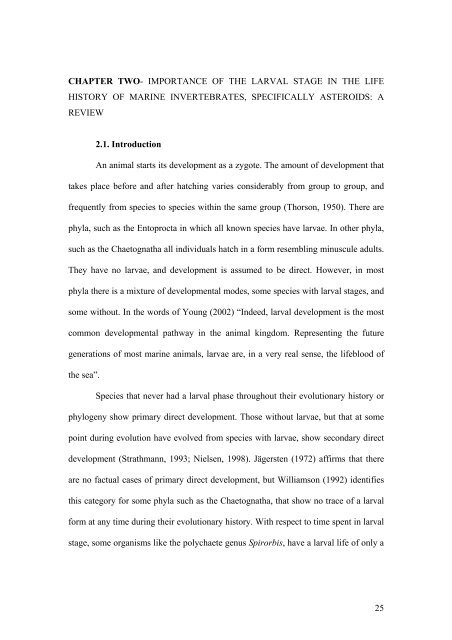Download (3398Kb) - ePrints Soton - University of Southampton
Download (3398Kb) - ePrints Soton - University of Southampton
Download (3398Kb) - ePrints Soton - University of Southampton
You also want an ePaper? Increase the reach of your titles
YUMPU automatically turns print PDFs into web optimized ePapers that Google loves.
CHAPTER TWO- IMPORTANCE OF THE LARVAL STAGE IN THE LIFE<br />
HISTORY OF MARINE INVERTEBRATES, SPECIFICALLY ASTEROIDS: A<br />
REVIEW<br />
2.1. Introduction<br />
An animal starts its development as a zygote. The amount <strong>of</strong> development that<br />
takes place before and after hatching varies considerably from group to group, and<br />
frequently from species to species within the same group (Thorson, 1950). There are<br />
phyla, such as the Entoprocta in which all known species have larvae. In other phyla,<br />
such as the Chaetognatha all individuals hatch in a form resembling minuscule adults.<br />
They have no larvae, and development is assumed to be direct. However, in most<br />
phyla there is a mixture <strong>of</strong> developmental modes, some species with larval stages, and<br />
some without. In the words <strong>of</strong> Young (2002) “Indeed, larval development is the most<br />
common developmental pathway in the animal kingdom. Representing the future<br />
generations <strong>of</strong> most marine animals, larvae are, in a very real sense, the lifeblood <strong>of</strong><br />
the sea”.<br />
Species that never had a larval phase throughout their evolutionary history or<br />
phylogeny show primary direct development. Those without larvae, but that at some<br />
point during evolution have evolved from species with larvae, show secondary direct<br />
development (Strathmann, 1993; Nielsen, 1998). Jägersten (1972) affirms that there<br />
are no factual cases <strong>of</strong> primary direct development, but Williamson (1992) identifies<br />
this category for some phyla such as the Chaetognatha, that show no trace <strong>of</strong> a larval<br />
form at any time during their evolutionary history. With respect to time spent in larval<br />
stage, some organisms like the polychaete genus Spirorbis, have a larval life <strong>of</strong> only a<br />
25
















